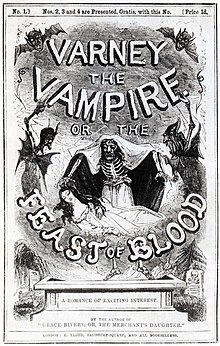Varney the Vampire

Cover from one of the original publications
|
|
| Author |
James Malcolm Rymer Thomas Peckett Prest |
|---|---|
| Country | United Kingdom |
| Language | English |
| Genre | Penny dreadful/Gothic horror |
|
Publication date
|
1845–47 (serial) 1847 (book) |
| Media type | |
| Pages | 876 (book) |
Varney the Vampire; or, the Feast of Blood is a Victorian era serialized gothic horror story by James Malcolm Rymer and Thomas Peckett Prest. It first appeared in 1845–47 as a series of weekly cheap pamphlets of the kind then known as "penny dreadfuls". The story was published in book form in 1847. It is of epic length: the original edition ran to 876 double-columned pages and 232 chapters. Altogether it totals nearly 667,000 words. Despite its inconsistencies, Varney the Vampire is more or less a cohesive whole. It is the tale of the vampire Sir Francis Varney, and introduced many of the tropes present in vampire fiction recognizable to modern audiences.
The story has a confused setting. While ostensibly set in the early eighteenth century, there are references to the Napoleonic Wars and other indicators that the story is contemporary to the time of its writing in the mid-nineteenth century. Varney's adventures also occur in various locations including London, Bath, Winchester, Naples and Venice.
The plot concerns the troubles that Sir Francis Varney inflicts upon the Bannerworths, a formerly wealthy family driven to ruin by their recently deceased father. Initially the Bannerworths consist of Mrs. Bannerworth and her adult children Henry, George and Flora. (George is never mentioned after the thirty-sixth chapter.) A family friend, Mr. Marchdale, lives with the Bannerworths in early chapters. Later, Flora's fiancé Charles Holland, his seafaring uncle Admiral Bell, and Bell's jovial assistant Jack Pringle also take residence with the Bannerworths.
Though the earliest chapters give the standard motives of blood sustenance for Varney's actions toward the family, later ones suggest that Varney is motivated by monetary interests. The story is at times inconsistent and confusing, as if the author did not know whether to make Varney a literal vampire or simply a human who acts like one. Varney bears a strong resemblance to a portrait in Bannerworth Hall, and the implication throughout is that he is actually Marmaduke Bannerworth (or Sir Runnagate Bannerworth; the names are confused throughout the story), but that connection is never clarified. He is portrayed as loathing his condition, and at one point he turns Clara Crofton, a member of another family he terrorizes, into a vampire for revenge.
...
Wikipedia
